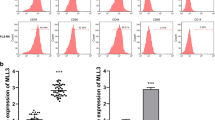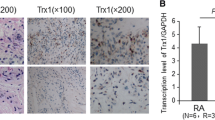Abstract
Apoptosis is reduced in the synovial tissue of patients with rheumatoid arthritis (RA), possibly due to decreased expression of pro-apoptotic genes. Programmed Cell Death 5 (PDCD5) has been recently identified as a protein that mediates apoptosis. Although PDCD5 is down-regulated in many human tumors, the role of PDCD5 in RA has not been investigated. Here we report that reduced levels of PDCD5 mRNA and protein are detected in RA synovial tissue (ST) and fibroblast-like synoviocytes (FLS) than in tissue and cells from patients with osteoarthritis (OA). We also report differences in the PDCD5 expression pattern in tissues from patients with these two types of arthritis. PDCD5 showed a scattered pattern in rheumatoid synovium compared with OA, in which the protein labeling was stronger in the synovial lining layer than in the sublining. We also observed increased expression and nuclear translocation of PDCD5 in RA patient-derived FLS undergoing apoptosis. Finally, overexpression of PDCD5 led to enhanced apoptosis and activation of caspase-3 in triptolide-treated FLS. We propose that PDCD5 may be involved in the pathogenesis of RA. These data also suggest that PDCD5 may serve as a therapeutic target to enhance sensitivity to antirheumatic drug-induced apoptosis in RA.





Similar content being viewed by others
References
Firestein GS (2003) Evolving concepts of rheumatoid arthritis [review]. Nature 423:356–361
Pap T, Müller-Ladner U, Gay RE, Gay S (2000) Fibroblast biology: role of synovial fibroblasts in the pathogenesis of rheumatoid arthritis. Arthritis Res 2:361–367
Baier A, Meineckel I, Gay S, Pap T (2003) Apoptosis in rheumatoid arthritis. Curr Opin Rheumatol 15:274–279
Liu HT, Wang YG, Zhang YM et al (1999) TFAR19, a novel apoptosis-related gene cloned from human leukemia cell lineTF-1, could enhance apoptosis of some tumor cells induced by growth factor withdrawal. Biochem Biophys Res Commun 254:203–210
Rui M, Chen YY, Zhang YM, Ma DL (2002) Transfer of anti-TFAR19 monoclonal antibody into HeLa cells by in situ electroporation can inhibit the apoptosis. Life Sci 71:1771–1778
Chen YY, Sun RH, Han WL et al (2001) Nuclear translocation of PDCD5 (TFAR19): an early signal for apoptosis? FEBS Lett 509:191–196
Hedenfalk I, Duggan D, Chen Y et al (2001) Gene-expression profiles in hereditary breast cancer. N Engl J Med 344:539–548
Xu XR, Huang J, Xu ZG et al (2001) Insight into hepatocellular carcinogenesis at transcriptome level by comparing gene expression profiles of hepatocellular carcinoma with those of corresponding noncancerous liver. Proc Natl Acad Sci USA 98:15089–15094
Yang YH, Zhao M, Li WM, Chen YY, Kang B, Lu YY (2006) Expression of programmed cell death 5 gene involves in regulation of apoptosis in gastric tumor cells. Apoptosis 11:993–1001
Ma X, Ruan GR, Wang Y, Li QY, Ma DL, Zhao HS (2005) Two single-nucleotide polymorphisms with linkage disequilibrium in the human PDCD5 gene 5’ regulatory region affect promoter activity and the susceptibility of CML in Chinese population. Clin Cancer Res 11:8592–8599
Spinola M, Meyer P, Kammerer S et al (2006) Association of the PDCD5 locus with lung cancer risk and prognosis in smokers. J Clin Oncol 24:1672–1678
Cheng AX, Lou SQ, Zhou HW, Wang Y, Ma DL (2004) Expression of PDCD5, a novel apoptosis related protein, in human osteoarthritic cartilage. Acta Pharmacol Sin 25:685–690
Arnett FC, Edworthy SM, Bloch DA et al (1988) The American Rheumatism Association 1987 revised criteria for the classification of rheumatoid arthritis. Arthritis Rheum 31:315–324
Altman R, Asch E, Bloch D et al (1986) Development of criteria for the classification and reporting of osteoarthritis. Classification of osteoarthritis of the knee. Diagnostic and Therapeutic Criteria Committee of the American Rheumatism Association. Arthritis Rheum 29:1039–1049
Gravallese EM, Manning C, Tsay A et al (2000) Synovial tissue in rheumatoid arthritis is a source of osteoclast differentiation factor. Arthritis Rheum 43:250–258
Ruan GR, Qin YZ, Chen SS et al (2006) Abnormal expression of the programmed cell death 5 gene in acute and chronic myeloid leukemia. Leuk Res 30:1159–1165
Kusunoki N, Yamazaki R, Kitasato H, Beppu M, Aoki H, Kawai S (2004) Triptolide, an active compound identified in a traditional Chinese herb, induces apoptosis of rheumatoid synovial fibroblasts. BMC Pharmacol 4:1–10
Pope RM (2002) Apoptosis as a therapeutic tool in rheumatoid arthritis [review]. Nat Rev Immunol 2:527–535
Antonsson B, Martinou JC (2000) The Bcl-2 protein family. Exp Cell Res 256:50–57
Deng YB, Lin YH, Wu XW (2002) TRAIL-induced apoptosis requires Bax-dependent mitochondrial release of Smac/DIABLO. Genes Dev 16:33–45
Deveraux QL, Reed JC (1999) IAP family proteins-suppressors of apoptosis. Genes Dev 13:239–252
Irmler M, Thome M, Hahne M et al (1997) Inhibition of death receptor signals by cellular FLIP. Nature 388:190–195
Pap T, Franz JK, Hummel KM, Jeisy E, Gay R, Gay S (2000) Activation of synovial fibroblasts in rheumatoid arthritis: lack of expression of the tumour suppressor PTEN at sites of invasive growth and destruction. Arthritis Res 2:59–64
Franz JK, Pap T, Hummel KM et al (2000) Expression of sentrin, a novel antiapoptotic molecule, at sites of synovial invasion in rheumatoid arthritis. Arthritis Rheum 43:599–607
Schedel J, Gay RE, Kuenzler P et al (2002) FLICE-inhibitory protein expression in synovial fibroblasts and at sites of cartilage and bone erosion in rheumatoid arthritis. Arthritis Rheum 46:1512–1518
Catrina AI, Ulfgren AK, Lindblad S, Grondal L, Klareskog L (2002) Low levels of apoptosis and high FLIP expression in early rheumatoid arthritis synovium. Ann Rheum Dis 61:934–936
Seemayer CA, Kuchen S, Neidhart M et al (2003) p53 in rheumatoid arthritis synovial fibroblasts at sites of invasion. Ann Rheum Dis 62:1139–1144
Cha HS, Rosengren S, Boyle DL, Firestein GS (2006) PUMA regulation and proapoptotic effects in fibroblast-like synoviocytes. Arthritis Rheum 54:5879–592
Perlman H, Georganas C, Pagliari LJ, Koch AE, Haines K III, Pope RM (2000) Bcl-2 expression in synovial fibroblasts is essential for maintaining mitochondrial homeostasis and cell viability. J Immunol 164:5227–5235
Perlman H, Liu H, Georganas C et al (2001) Differential expression pattern of the antiapoptotic proteins, Bcl-2 and FLIP, in experimental arthritis. Arthritis Rheum 44:2899–2908
Zhang HG, Huang N, Liu D et al (2000) Gene therapy that inhibits nuclear translocation of nuclear factor (B results in tumor necrosis factor α-induced apoptosis of human synovial fibroblasts. Arthritis Rheum 43:1094–1105
Chen LN, Wang Y, Ma DL, Chen YY (2006) Short interfering RNA against the PDCD5 attenuates cell apoptosis and caspase-3 activity induced by Bax overexpression. Apoptosis 11:101–111
Wang Y, Li XT, Wang L et al (2004) An alternative form of paraptosis-like cell death, triggered by TAJ/TROY and enhanced by PDCD5 overexpression. J Cell Sci 117:1525–1532
Matsumoto S, Muller-Ladner U, Gay RE, Nishioka K, Gay S (1996) Ultrastructural demonstration of apoptosis, Fas and Bcl-2 expression of rheumatoid synovial fibroblasts. J Rheumatol 23:1345–1352
Acknowledgments
This work was supported by grants from the National Basic Research Program (973 Program, 2002CB513000) and the National Natural Science Foundation of China (30470844). The authors thank Prof. Da-Long Ma (Peking University, Beijing) for advice and guidance. Conflict of Interest: The authors declare that they have no competing interests.
Author information
Authors and Affiliations
Corresponding author
Rights and permissions
About this article
Cite this article
Wang, N., Lu, HS., Guan, ZP. et al. Involvement of PDCD5 in the regulation of apoptosis in fibroblast-like synoviocytes of rheumatoid arthritis. Apoptosis 12, 1433–1441 (2007). https://doi.org/10.1007/s10495-007-0070-z
Published:
Issue Date:
DOI: https://doi.org/10.1007/s10495-007-0070-z




